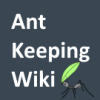Example: Species: - Tip/Trick -Username
Species: Brachyamyrmex Depilis- Can be found mating on lightly colored cars in the afternoon. Colony's can be found living in abandoned ant hills. I usually find them living in Formica hills that have been abandoned. Very small and hard to spot. -Major
Species: Camponotus pensylvanicus, Camponotus subbarbatus, Camponotus nearcticus - Can be found walking around. You can find these queens from quite the distance because of their size. I have found them several times in my grassy yard. -AntsAreUs
Species: Formica incerta, Formica subsericea, Formica neorufibarbis - Can be found walking around in the afternoon on hot, sunny days during June through August. -AntsAreUs
Species: Formica rubicunda - I've found them trying to harass colonies of Formica subsericea alongside forest edges. -AntsAreUs
Species: Lasius Brevicornis - Often found under rocks, colony's are quite shallow. -Major
Species: Lasius claviger - They fly during late Fall. Queens hibernate in huge masses together under stones and logs. Queens can also be found during early Spring. -AntsAreUs
Species: Lasius murphyi - Queens can be found walking around everywhere in the evening right after rain in July. -AntsAreUs
Species: Leptogenys sp - The never have any nuptial flights. To find them, follow their foraging trails and you will usually end up at a pile of leaves. Scoop ALL THE LEAVES UP. Catch any stragglers. -Leo
Species: Myrmecina americana - Personally, I have only found them numerous under stones during early Spring. I'm sure they fly during late Fall. -AntsAreUs
Species: Myrmica spp - Queens can be found foraging next to small roads on sandy dirt areas. -Major
Species: Pheidole pilifera - Found literally right after moderate to heavy rain. Queens can be found making claustral chambers into the evening normally in sandy soil. -AntsAreUs
Species: Ponera pennsylvanica - They fly in September and October. Queens can be found under stones and logs during late Fall, early Spring, and even into Summer. -AntsAreUs
Prenolepis Imparis (Winter Ant): I have found them on the first day in April above 70 degrees (Farenheit) and shortly after a rainstorm. (I live in New york, I can't really speak for anywhere else.) -disasterants
Species: Solenopsis molesta - Flights take place during or after sunset. Queens can be found making chambers alongside roads in open soil. -AntsAreUs
Species: Stenamma spp. - Alates can be found throughout the year because they overwinter a portion of their alates occasionally. They can be found under stones and logs in September mostly. -AntsAreUs
Species: Stigmatomma pallipes - Very inconsistent. Can be found as early as July and as late as October. Personally I have recently found a male. -AntsAreUs
Species: Temnothorax Curvispinosus: Look next to dirt covered areas near trees and creeks. They can be caught with blacklight, or you can find them at around 7 PM. 6-9 is probably best. -Major
Species: Temnothorax Longispinosus: Colonys of up to 100 workers can be found in nuts. Be careful with this method though. They do have satellite nests. So you are taking a risk of not catching the queen or the whole colony. -Major
Species: Temnothorax spp. - Can vary quite a bit. I've heard that they fly a little before midnight but I have found them in the afternoon. Generally hard to spot unless you have a black light. -AntsAreUs
Species: Tetramorium immigrans - Here spend most of their time trying to dig on the sides of roads. They fly very early in the morning, normally during sunrise. -AntsAreUs
Feel free to post on this thread! This will help us all!
Edited by Major, August 27 2018 - 11:40 AM.



















